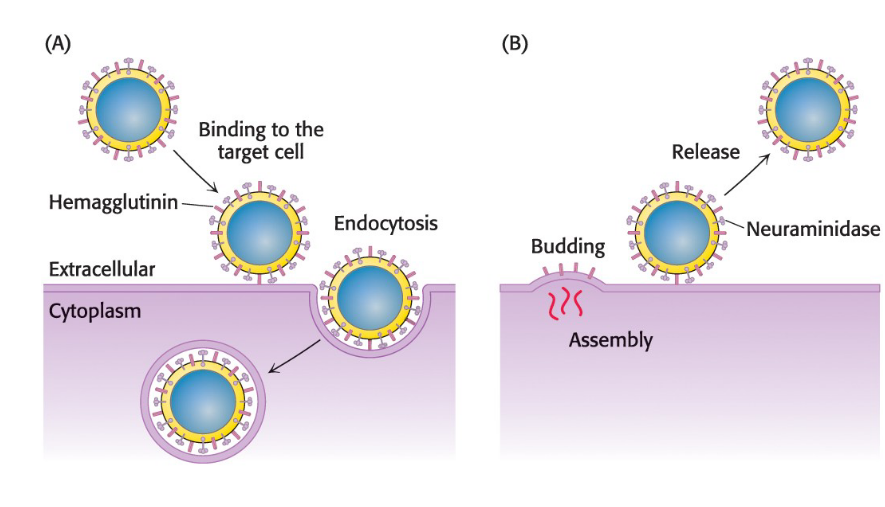Chapter 11- Carbohydrates and Glycoproteins
1/61
There's no tags or description
Looks like no tags are added yet.
Name | Mastery | Learn | Test | Matching | Spaced |
|---|
No study sessions yet.
62 Terms
Carbohydrates
carbon-based molecules high in hydroxyl groups
empirical formula: (CH2O)n
can have additional groups or modifications
better described as polyhydroxy aldehydes and ketones (and their derivatives)
Monosaccarides
Aldehydes or ketones that contain two or more hydroxyl groups
3-7 carbons in length
Exist in many isomeric forms and are called simple sugars
Serve as fuel
Nomenclature is based on carbon-chain length and identity of most oxidized group:
Keto group:ketose
aldehyde: aldose
Constitutional isomer
Molecules with indentical molecular formulas that differ in how the atoms are ordered
Stereoisomer
molecules that differ in spatial arrangement but not bonding order
have either D or L configuration
can be enantiomers (mirror images of each other) or diastereoisomers (not mirror images of each other)
number possible = 2n where n is the number of asymmetric carbon atoms
Epimers
Sugars that are diasteroisomers differing in configuration only at a single asymmetric center
True or false: Most monosaccharides exist as interchanging cyclic forms
True
an aldehyde can react with an alcohol to form a hemiacetal
a ketone can react with an alcohol to form a hemiketal
Anomer
a diastereoisomeric form of sugars that forms when a cyclic hemiacetal is formed and an additional asymmetric center is created
In glucose, C-1 (the anomeric carbon atom) becomes an
asymmetric center, forming two ring structures:
α-D-glucopyranose (hydroxyl group attached to C-1 is on the opposite side of the ring as C-6)
β-D-glucopyranose hydroxyl group attached to C-1 is on the same side of the ring as C-6)
Chair form of glucose
Substituents on the carbon ring atoms can be axial (nearly perpendicular) or equatorial (nearly parallel)
Axial substituents sterically hinder each other if on the same side of the ring
Predominates because all axial positions are occupied by hydrogens

Boat form of glucose
Disfavored because it is sterically hindered

Blood sugar
D-glucose circulating in the blood
only fuel used by the brain in non-starvation conditions
Only fuel used by red blood cells
Why is D-glucose an important fuel?
glucose is formed from formaldehyde under prebiotic conditions and may have been available as a fuel source for primitive biochemical systems
glucose is relatively inert
the most stable ring structure is β-D-glucopyranose
D-Glucose
Reducing sugar that reacts nonenzymatically with hemoglobin
in its linear form, glucose can react with oxidizing agents
How can you use reducing sugars to test if a molecule is a reducing sugar?
Fehling’s solution = solutions of Cu2+ that test for the presence of sugars that adopt an open structure
Reducing sugars= sugars that react with oxidizing agents
all monosaccharides that can adopt linear structures in solution
non-reducing sugars= sugars that do not react with oxidizing agents
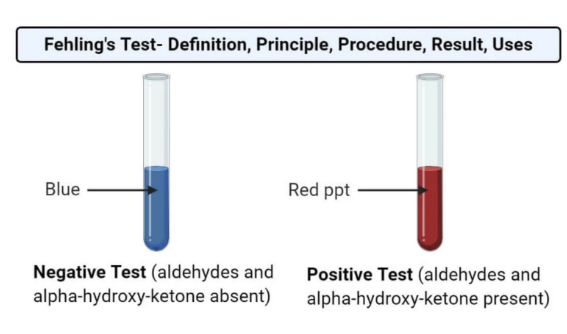
Glycation
Nonenzymatic addition of a carbohydrate to another molecule
ex. Reducing sugars nonspecifically react with free amino groups on proteins (often Lys or Arg) to form a stable covalent bond
D-glucose has a low tendency to glycate proteins unless concentrations of sugar and protein are very high for long periods of time
Advanced glycation end products (AGEs) = products resulting from cross-linking following the primary modification
implicated in aging, arterioschlerosis, diabetes, and other pathological conditions
How to assess for diabetes by monitoring A1C levels
D-glucose reacts with hemoglobin to form glycated hemoglobin (hemoglobin A1c, A1C).
has no effect on O2 binding
In nondiabetic individuals, <6% of the hemoglobin is glycated.
In patients with uncontrolled diabetes, almost 10% of the hemoglobin is glycated.
Only eliminated when RBC’s die (lifespan is about 120 days)
Monosaccharide biochemical properties can be modified by reactions with:
alcohols
amines
phosphates
Can also be modified by the addition of substituents other than hydroxyl groups
What do monosaccharide modifications help with?
Can serve as signal molecules
can facilitate metabolism
How are Monosaccharides joined to alcohols and amines?
Glycosidic linkages
O-Glycosidic Linkage
Covalent linkage formed between the anomeric carbon atom of a carbohydrate and the oxygen atom of an alcohol
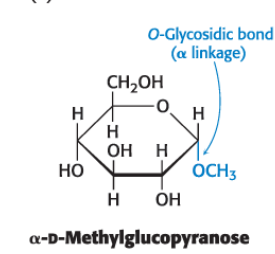
N-glycosidic linkage
Covalent linkage formed between the anomeric carbon atom of a carbohydrate and the nitrogen atom of an amine
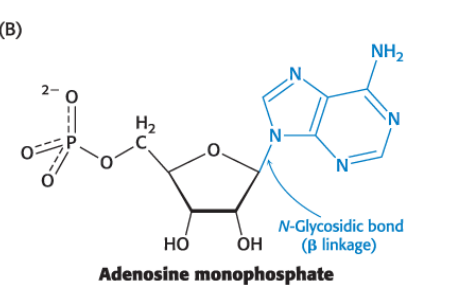
Phosphorylated sugars
Phosphorylation is a common modification of sugars in
metabolic reactions → Makes sugars ionic
Purposes:
makes sugars anionic to prevent crossing the lipid-bilayer membranes and interacting with transporters of the unmodified sugar
blocks the formation of alternative ring conformation
creates reaction intermediates that more readily undergo metabolism
Oligosaccharides
sugars that contain two or more monosaccharides linked by O-glycosidic bonds
have directionality defined by their reducing and
nonreducing ends
ex. Maltose (disaccharide of D-glucose)
α-1,4-glycosidic linkage = glycosidic linkage between the α-anomeric form of C-1 on one sugar and the hydroxyl oxygen atom on C-4 of the adjacent sugar
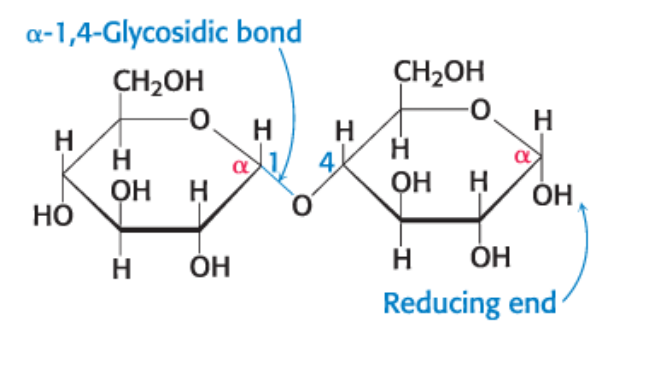
Reducing end in oligosaccharides
Has a free anomeric carbon atom that can form the open-chain form
Nonreducing end
Has an anomeric carbon in a glycosidic linkage that cannot convert to the open-chain form
Disaccharide
Two sugars linked by an O-glycosidic linkage
Cleavage products of disaccharides can be processed to provide energy in the form of ATP
ex. sucrose, lactose, maltose
Sucrose
Disaccharide of sugar cane or sugar beets that consists of glucose linked to fructose
anomeric carbon of glucose is linked to the anomeric carbon of fructose
the configuration is α for glucose and β for fructose
– not a reducing sugar
– can be cleaved by sucrase (invertase)
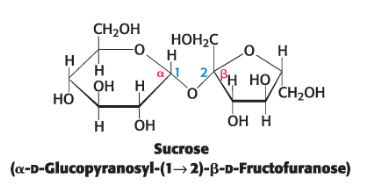
Lactose
Lactose = disaccharide of milk that consists of a galactose linked to a glucose
linked by a β-1,4-glycosidic linkage.
can be hydrolyzed by lactase in human beings and by β- galactosidase in bacteria
Lack of lactase leads to lactose intolerance
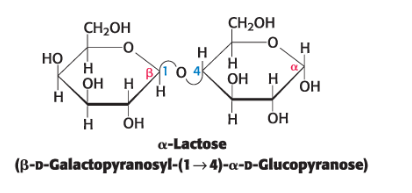
Maltose
disaccharide resulting from the hydrolysis of large oligosaccharides that consists of two linked glucose molecules
joined by an α-1,4-glycosidic linkage
can be hydrolyzed to glucose by maltase (α-glucosidase)
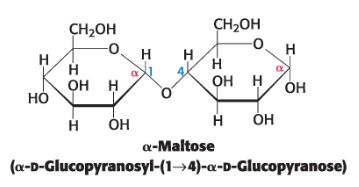
Glycogen and starch are storage forms of glucose
Free glucose cannot be stored because high concentrations will disturb the cell’s osmotic balance
polysaccharides (glycans)
Large polymeric oligosaccharides formed by the linkage of multiple monsaccharides
polysaccharides plays a role in energy storage and structural integrity
homopolymer
Homopolymer
Polymer in which all the monosaccharide units are the same
Glycogen
Large, branched polymer of glucose residues
most common homopolymer in animal cells
storage form of glucose
most glucose units are linked by α-1,4-glycosidic linkages
branches are formed by α-1,6-glycosidic linkages hydrolyzed by α-amylase
Branching increases the surface area to allow better
access for enzymes to rapidly breakdown glycogen.
Starch
homopolymer that serves as the nutritional reservoir in plants
Two forms: amylose and amylopectin
amylose= unbranched type of starch composed of
glucose residues in α-1,4 linkageamylopectin = branched type of starch with ~1 α-1,6 linkage per 30 α-1,4 linkages
identical structure to glycogen but with a lower degree of branching
Amylose and amylopectin are hydrolyzed by α-amylase.
chitin
Main structural poplysaccharide of fungi and arthropods
homopolymer of β-1,4 linked N-acetylglucosamine
found in fungal cell walls and exoskeletons and shells of arthropods
Fibers are often crosslinked and composited with minerals and proteins to increase rigidity and strength.
How are insoluble and soluble fibers an important part of the diet?
Mammals cannot digest cellulose because they lack cellulases, but plant fibers are still important in the mammalian diet.
Insoluble fibers increase the rate at which digestion products pass through the large intestine.
softens stools and makes them easier to pass
Soluble fibers (e.g., pectin or polygalacturonic acid) slow the movement of food through the gastrointestinal tract.
facilitates absorption of nutrients from the diet
Chitosan
Cellulose is a major constituent of paper, bioadhesives, and clothes.
Chitin could be recovered from the shellfishing industry by processing the shells into the more versatile chitosan through microbial/enzymatic processes.
Chitosan can be used as:
a carrier to assist in drug delivery.
a component of cosmetic and food products.
a surgical dressing.
Glycoprotein
a carbohydrate group covalently attached to a protein
makes up 50% of the human proteome
glycosylation increases the complexity of the proteome
glycoforms = different glycosylated forms
may occur when a protein has several potential glycosylation sites
3 classes of glycoproteins
glycoproteins = predominantly proteins
play a variety of roles, including cell adhesion
proteoglycans = predominantly carbohydrates and the protein component is conjugated to a glycosaminoglycan
function as structural components and lubricants
mucins (mucoproteins) = predominantly carbohydrates and the protein components is extensively glycosylated at Ser or Thr residues, usually by N-acetylgalactosamine
key component of mucus
function as lubricants
How can carbohydrates be linked to proteins?
Through N-linked or O-linked
N-linkage
Links the sugars in glycoproteins to the amide nitrogen atom in the side chain of Asn
Asn must be part of an Asn-X-Ser or Asn-X-Thr sequence, where X is any residue execept proline
O-linkage
Links the sugar in glycoproteins to the oxygen atom in the side chain of Ser or Thr
N-linked oligosaccharides common core
Consists of 3 mannoses and two N-acetylglucosamine residues
GlcNAcylation
the post-translational, covalent attachment of a single N- acetylglucosamine (GlcNAc) to Ser or Thr residues of proteins
Type of glycosylation
catalyzed by O-GlcNAc transferase
occurs when nutrients are abundant
reversible
O-GlyNAc Transferase
GlcNAcylation sites are potential phosphorylation sites → O-GlycNAc transferase and protein kinases may be involved in cross talk
Improper regulation O-GlcNAc transferase has been linked to:
insulin resistance
diabetes
cancer
neurological pathologies
Proteoglycans
proteins attached to glycosaminoglycans
up to 95% glycosaminoglycan by weight
resembles a polysaccharide more than a protein
function as lubricants and structural components in connective tissue.
mediate adhesion of cells to extracellular matrix.
bind factors that regular cell proliferation.
Important components of cartilage
Cartilage contains the protein collagen and the proteoglycan aggrecan.
aggrecan = large molecule with three globular domains
site of glycosaminoglycan (keratan sulfate and chondroitin sulfate) attachment is in the extended region between G2 and G3
G1 noncovalently binds to a central polymer of hyaluronate
Glucose flat and ring form
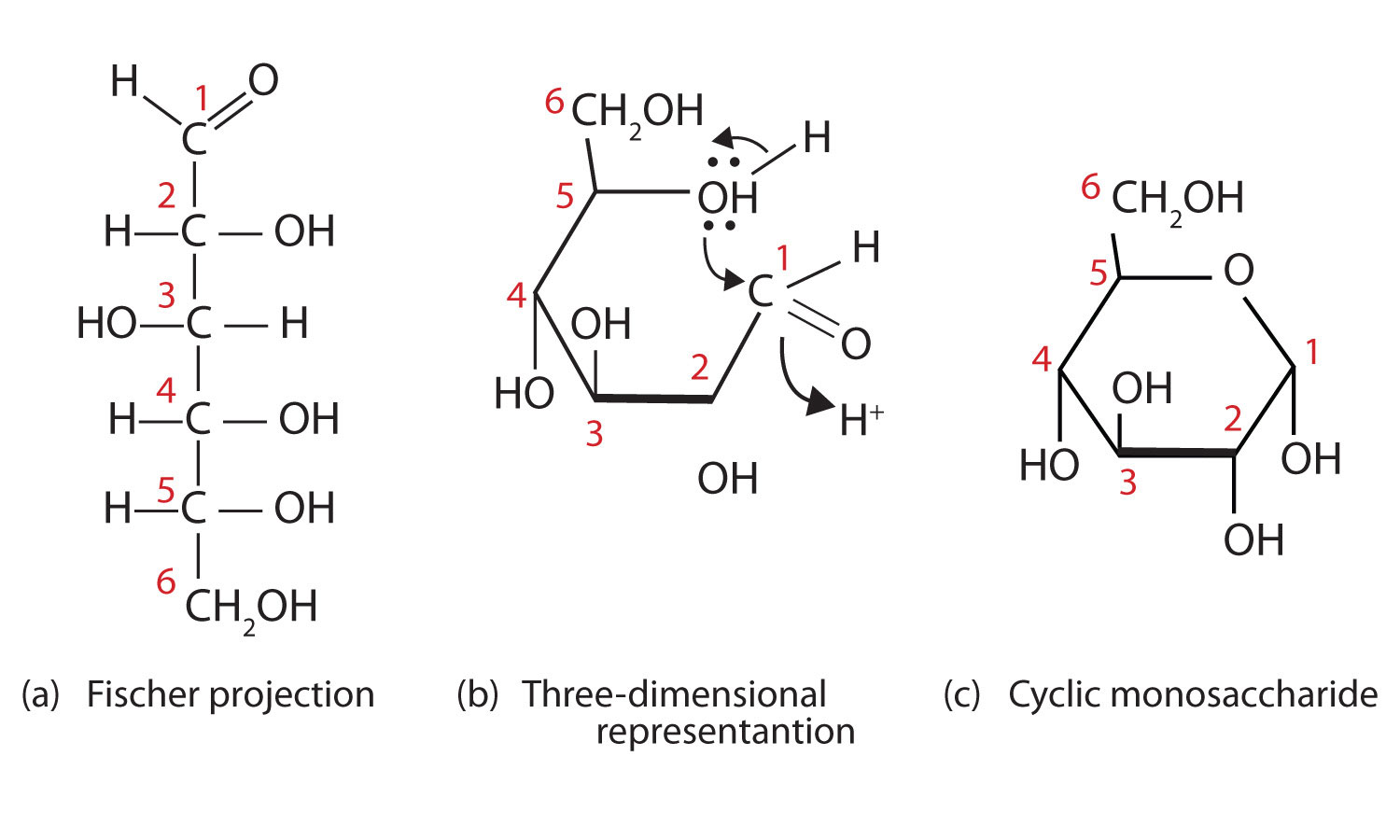
Glycosaminoglycans
composed of repeating units of disaccharides containing a derivative of an amino sugar
amino sugar derivative is either glucosamine or galactosamine
at least one of the two sugars in the unit has a negatively charged carboxylate or sulfate group
The inability to degrade glycosaminoglycans causes diseases marked by skeletal deformities and reduced life expectancies.
How aggregan cushions compressive forces
Water is bound to the glycosaminoglycans to cushion compressive forces.
Water is squeezed from the glycosaminoglycan under pressure.
Water rebinds when pressure is released.
osteoarthritis = form of arthritis that results when water is lost from proteoglycan with aging
Tandem Repeats (VNTR) Region
region of the protein backbone of mucins that is rich in O-glycosylated Ser and Thr residues
Core carbohydrate structures are conjugated to the protein component of mucin.
Mucins are glycoprotein components of Mucus
Mucins
adhere to epithelial cells and act as a protective barrier.
hydrate the underlying cells.
play roles in fertilization, the immune response, and cell adhesion.
Overexpression occurs in bronchitis, cystic fibrosis, and adenocarcinomas.
Where does protein glycosylation take place?
In the lumen of the endoplasmic reticulum and the Golgi Complex
Endoplasmic reticulum (ER) and Golgi complex are organelles that play central roles in protein trafficking.
N-linked glycosylation begins in the ER and continues in the Golgi complex.
O-linked glycosylation occurs only in the Golgi complex.
Golgi complex
stack of flattened membraneous sacs
sorting center
proteins have to go through Golgi and ER first to undergo modifications before the Golgi sends out proteins to wherever they are needed
proteins proceed to lysosome, secretory granules, or the plasma membrane
based on signals encoded within their amino acid sequences and 3-D structures
Glycosyltransferases
Catalyze the formation of glycosidic linkages
Responsible for oligosaccharide assembly
Activated sugar nucleotides are the most common carbohydrate donor for glycosyltransferases
Blood groups and protein glycosylation patterns
Blood groups are designated by the presence of one of the three different carbohydrates (A, B, or O) attached to glycoproteins and glycolipids on the surfaces of red blood cells.
All blood groups have a core O antigen.
Specific glycosyltransferases add the extra monosaccharide to the O antigen
A and B antigens have on extra monosaccharide through an α-1,3 linkage to a galactose moiety of the O antigen
added by specific glycosyltransferases
type A transferase = adds N acetylgalactosamine to form the A antigen
type B transferase = adds galactose to form the B antigen
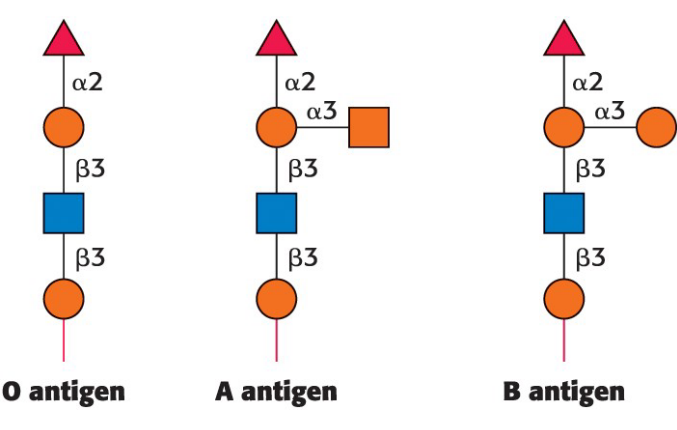
Blood type phenotypes
Individuals with the:
O blood type lack both enzymes.
AB blood type express both enzymes.
A blood type express only type A transferase.
B blood type express only type B transferase.
have important implications for blood transfusions.
If an antigen not normally present is introduced, the immune system recognizes it as foreign.
I-cell disease
a lysosomal storage disease that causes severe psychomotor impairment and skeletal deformities
affected lysosomes contain undigested glycosaminoglycans and glycolipids
active enzymes responsible for degradation are synthesized
enzymes lack appropriate glycosylation and are exported instead of being sequestered in lysosomes
A mannose 6-phosphate residue of the N-oligosaccharide directs the enzymes from the Golgi complex to lysosomes.
In I-cell disease, the mannose lacks a phosphate because patients are deficient in the N-acetylglucosamine phosphotransferase
Glycan-binding proteins
Bind to specific carbohydrate structures on neighboring cell surfaces
ex. lectins
Lectins
Type of glycan-binding proteins
the mannose 6-phosphate receptor that binds and directs lysosomal enzymes to the lysosome
function to facilitate cell–cell contact.
helps to build tissues
usually contains 2+ carbohydrate-binding sites.
are linked to carbohydrates by a number of weak noncovalent interactions.
composite of interactions is strong
C-type lectins
calcium-requiring lectins = found in animals
function in receptor-mediated endocytosis and cell-cell recognition
Ca2+ on lectin acts as a bridge between lectin and the sugar.
Two Glu residues in lectin bind to Ca2+ and the sugar.
Other hydrogen bonds form between lectin side chains and the carbohydrate.
selectins are a type of C-type lectins
L-type lectins
rich in seeds of leguminous plants
serve as potential toxins to herbivorous insects
some act as chaperones in the eukaryotic ER
Selectins
Members of C-type lectins
bind immune-system cells to sites of injury in the inflammatory response
play a role in recruiting leukocytes to inflammation sites
L form = bind to carbohydrates on lymph-node vessels
E form = bind to carbohydrates on endothelium
P form = bind to carbohydrates on activated blood platelets
Influenza
hemagglutinin = influenza virus lectin protein that binds to carbohydrates sialic acid residues linked to galactose residues on cell-surface glycoproteins
the virus is engulfed after binding
The virus replicates inside the cell and viral particles bud off from the cell.
Assembled viral particles are attached to sialic acid residues of the cell membrane by hemagglutinin.
neuraminidase (sialidase) = influenza virus protein that cleaves the glycosidic linkages between sialic acid and the rest of the glycoprotein
frees the virus to infect new cells
inhibitors of neuraminidase (Tamiflu and Relenza) are important anti-influenza agents
